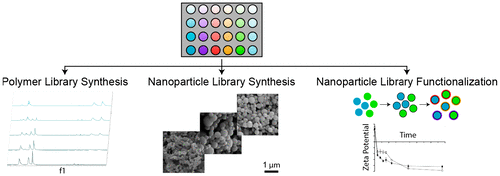当前位置:
X-MOL 学术
›
ACS Comb. Sci.
›
论文详情
Our official English website, www.x-mol.net, welcomes your
feedback! (Note: you will need to create a separate account there.)
Automated High-Throughput Synthesis of Protein-Loaded Polyanhydride Nanoparticle Libraries
ACS Combinatorial Science Pub Date : 2018-04-04 00:00:00 , DOI: 10.1021/acscombsci.8b00008 Jonathan T. Goodman 1 , Adam S. Mullis 1 , Lucas Dunshee 1 , Akash Mitra 1 , Balaji Narasimhan 1
ACS Combinatorial Science Pub Date : 2018-04-04 00:00:00 , DOI: 10.1021/acscombsci.8b00008 Jonathan T. Goodman 1 , Adam S. Mullis 1 , Lucas Dunshee 1 , Akash Mitra 1 , Balaji Narasimhan 1
Affiliation

|
The development of high-throughput techniques and combinatorial libraries can facilitate rapid synthesis and screening of biomaterial-based nanocarriers for drug and vaccine delivery. This study describes a high-throughput method using an automated robot for synthesizing polyanhydride nanoparticles encapsulating proteins. Polyanhydrides are a class of safe and biodegradable polymers that have been widely used as drug and vaccine delivery vehicles. The robot contains a multiplexed homogenizer and has the capacity to handle parallel streams of monomer or polymer solutions to synthesize polymers and/or nanoparticles. Copolymer libraries were synthesized using the monomers sebacic acid, 1,6-bis(p-carboxyphenoxy)hexane, and 1,8-bis(p-carboxyphenoxy)-3,6-dioxactane and compared to conventionally synthesized copolymers. Nanoparticle libraries of varying copolymer compositions encapsulating the model antigen ovalbumin were synthesized using flash nanoprecipitation. The amount of the surfactant Span 80 was varied to test its effect on protein encapsulation efficiency as well as antigen release kinetics. It was observed that, although the amount of surfactant did not significantly affect protein release rate, its presence enhanced protein encapsulation efficiency. Protein burst and release kinetics from conventionally and combinatorially synthesized nanoparticles were similar even though particles synthesized using the high-throughput technique were smaller. Finally, it was demonstrated that the high-throughput method could be adapted to functionalize the surface of particle libraries to aid in the design and screening of targeted drug and vaccine delivery systems. These results suggest that the new high-throughput method is a viable alternative to conventional methods for synthesizing and screening protein and vaccine delivery vehicles.
中文翻译:

自动化的高通量合成蛋白质负载的聚酸酐纳米粒子库
高通量技术和组合库的发展可以促进药物和疫苗递送的基于生物材料的纳米载体的快速合成和筛选。这项研究描述了使用自动化机器人合成包裹蛋白质的聚酸酐纳米粒子的高通量方法。聚酸酐是一类安全且可生物降解的聚合物,已被广泛用作药物和疫苗的运输工具。该机器人包含一个多路均化器,并具有处理单体或聚合物溶液平行流以合成聚合物和/或纳米粒子的能力。使用单体癸二酸,1,6-双(对羧基苯氧基)己烷和1,8-双(p-羧基羧氧基)-3,6-二氧杂环丁烷并与常规合成的共聚物进行比较。使用快速纳米沉淀法合成了包封模型抗原卵清蛋白的各种共聚物组成的纳米粒子库。改变表面活性剂Span 80的量以测试其对蛋白质包封效率以及抗原释放动力学的影响。观察到,尽管表面活性剂的量没有显着影响蛋白质的释放速率,但是其存在增强了蛋白质的包封效率。尽管使用高通量技术合成的颗粒较小,但常规和组合合成的纳米颗粒的蛋白质爆发和释放动力学相似。最后,结果表明,高通量方法可适用于功能化颗粒库的表面,以帮助设计和筛选靶向药物和疫苗输送系统。这些结果表明,新的高通量方法是合成和筛选蛋白质和疫苗输送载体的常规方法的可行替代方法。
更新日期:2018-04-04
中文翻译:

自动化的高通量合成蛋白质负载的聚酸酐纳米粒子库
高通量技术和组合库的发展可以促进药物和疫苗递送的基于生物材料的纳米载体的快速合成和筛选。这项研究描述了使用自动化机器人合成包裹蛋白质的聚酸酐纳米粒子的高通量方法。聚酸酐是一类安全且可生物降解的聚合物,已被广泛用作药物和疫苗的运输工具。该机器人包含一个多路均化器,并具有处理单体或聚合物溶液平行流以合成聚合物和/或纳米粒子的能力。使用单体癸二酸,1,6-双(对羧基苯氧基)己烷和1,8-双(p-羧基羧氧基)-3,6-二氧杂环丁烷并与常规合成的共聚物进行比较。使用快速纳米沉淀法合成了包封模型抗原卵清蛋白的各种共聚物组成的纳米粒子库。改变表面活性剂Span 80的量以测试其对蛋白质包封效率以及抗原释放动力学的影响。观察到,尽管表面活性剂的量没有显着影响蛋白质的释放速率,但是其存在增强了蛋白质的包封效率。尽管使用高通量技术合成的颗粒较小,但常规和组合合成的纳米颗粒的蛋白质爆发和释放动力学相似。最后,结果表明,高通量方法可适用于功能化颗粒库的表面,以帮助设计和筛选靶向药物和疫苗输送系统。这些结果表明,新的高通量方法是合成和筛选蛋白质和疫苗输送载体的常规方法的可行替代方法。











































 京公网安备 11010802027423号
京公网安备 11010802027423号